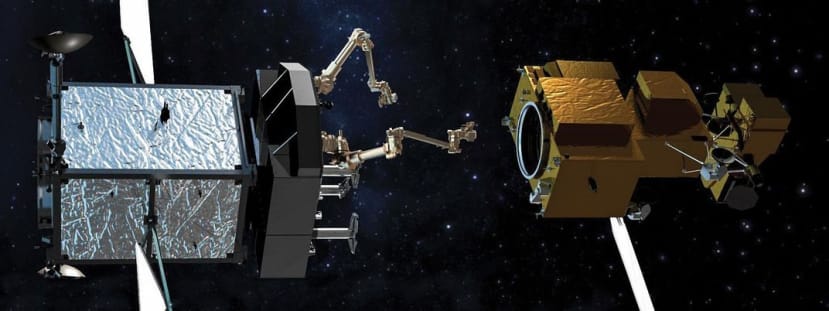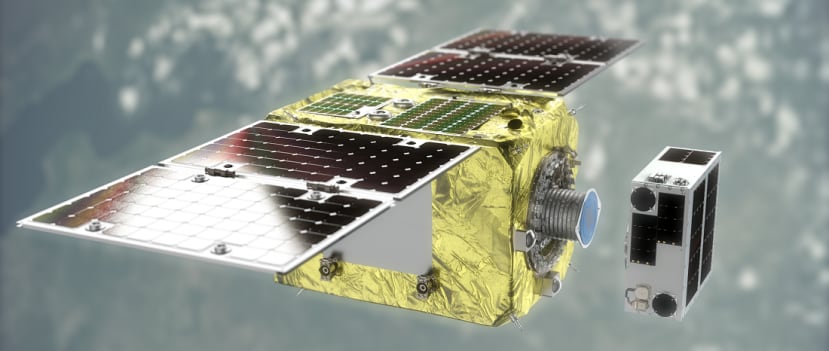The Scourge of Space Junk, Part 2: Solutions?
Follow articleHow do you feel about this article? Help us to provide better content for you.
Thank you! Your feedback has been received.
There was a problem submitting your feedback, please try again later.
What do you think of this article?
Artist’s impression of the OSAM-1 robotic service vehicle about to grab an ailing satellite. It will use its three dexterous limbs not only to capture and refuel depleted satellites but to disassemble and repair them too.
Image credit: NASA
Planet Earth is surrounded by a cloud of orbiting objects almost all of them man-made, from spent rocket stages, dead and functioning satellites to bits of debris. A theoretical collision problem is starting to look serious with the lives of astronauts at stake; mainly those working on the International Space Station (ISS). Solutions are needed.
Damage inflicted on a window of the International Space Station when UK astronaut Tim Peake was on board. Fortunately, it didn’t penetrate all the way through. Looking like a severe stone impact on a car windscreen, it’s believed to have been caused by a mere fleck of paint. The damaged area is about 1cm across.
Image credit: ESA
Where does it all come from?
The term ‘Space Junk’ is often used instead of Space Debris, but in fact, they are two different things. Space Junk conjures up images of very large items such as discarded rocket stages, usually second or third as the big first stages don’t achieve orbital velocity and fall back to Earth immediately. First stage boosters don’t burn up, but only those of the Space Shuttle and SpaceX’s Falcon 9 rocket were/are recovered for re-use. Then there are early communication, weather or ‘spy’ satellites that have come to the end of their lives; but as they come from a period when nobody bothered about the consequences we face now, they’re still orbiting, tumbling and out of control. Actually, these big lumps of scrap are not the worst problem because they're highly visible and easily tracked. They become hazardous to people on the surface if they are knocked out of orbit in a collision and are big enough for substantial chunks not burning up before hitting the ground. Such a collision also has the potential to create thousands of tiny bits of orbiting wreckage or Space Debris. Each piece will most certainly have its velocity changed. Remember, velocity includes speed and direction, so something losing velocity will drop towards the Earth into an orbit full of atmospheric drag causing it to burn up. An increase in velocity may see the debris pushed into an even higher, elliptical orbit. The upside of this potentially disastrous crash is that the small pieces have little mass and those thrown into the upper reaches of the atmosphere will suffer a rapid loss of momentum when encountering just a few molecules of gas. The downside, as I’ve already mentioned, is that debris remaining in orbit like that paint chip turns into an undetectable missile travelling at perhaps 18,000 mph. Low mass but high velocity yields enough momentum to penetrate the skin of a spacecraft.
Astroscale successfully launched its End-of-Life Services by Astroscale demonstration (ELSA-d) mission in March this year. It consists of two satellites stacked together — a servicer designed to safely remove debris from orbit and a client satellite that serves as a piece of replica debris. The servicer docks with the errant satellite using a powerful electromagnet.
Image credit: Astroscale
International politics
Ever since Spy satellites became a reality in the 1960s, countries being spied upon have been researching methods of neutralising them. Anti-satellite weapon systems (ASAT) have been tested by the US, USSR, China and recently India. Many of them were based on anti-aircraft technology: launching a guided missile, or in the jargon, Kinetic Kill Vehicle to impact and shatter the target. In fact, issues of orbital mechanics make it a very difficult proposition with rare successes being due more to luck than design. In 1985 a US missile launched from a fighter jet finally managed to destroy a redundant satellite. No further attempts were made. In 2007 China destroyed one of its own weather satellites in polar orbit. The impact at an altitude of 500 miles meant that a lot of the debris remains in orbit. Only two years ago, in 2019 India decided to show off its military reach by shattering a satellite in LEO despite the by now growing concern over the reckless generation of space debris. The orbit was much lower, so a greater portion of the wreckage should have burned up in the atmosphere by now. We hope.
Kessler Syndrome
In 1978 NASA scientist Donald Kessler proposed a theory that if the quantity of space junk in orbit reached a critical level, it could result in a chain reaction where more and more objects collide, creating new space debris in the process, just like a nuclear reaction. At some point, it becomes impossible to conduct safely any operations in Earth's orbit. We haven’t reached that extreme yet but we’re getting there. The first documented accidental collision between two satellites occurred in 2009 between a US Iridium communications satellite and a Russian military satellite, Kosmos 2251. Both were destroyed yielding some 2300 trackable fragments.
A Chinese space-mining start-up company just launched a robot prototype called NEO-1 into LEO capable of scooping up debris and other junk with a giant net.
Image credit: Origin Space
What can be done about it?
I discussed some basic principles behind removing the larger items of Space junk in Part 1 of this series. These included not turning relatively small numbers of detectable, avoidable large items into huge quantities of tiny, almost invisible but lethal ‘bullets’. Not much can be done about the existing cloud of debris particles except to mitigate the effects of impact. Most large spacecraft, especially manned ones have critical areas protected by a kind of ‘spaced armour’ called a Whipple Shield. The word ‘spaced’ is used literally, meaning that the shield and the spacecraft hull are separated by a gap.
Defensive armour
The first tanks used in World War 1 were built of thick steel sheet designed to protect the occupants from machine gun bullets and shell fragments. An up to then barely-noticed phenomenon became of great concern to tank crews: the armour plate’s tendency to spall or flake shards of metal inside the vehicle when a projectile hit the outside. The projectile did not penetrate – the plating itself shed lumps of metal travelling at high speed which were just as deadly. The same would happen to astronauts in a spacecraft, even if a rocket able to lift the massive extra weight of heavy armour were available!
Those of you familiar with military equipment will know all about spaced armour: it’s been used to protect tanks from armour-piercing shells for decades. In the case of a tank, the principle is that a shell explodes on contact with the outer shield and penetrates it, losing most of its kinetic energy in the process. The inner plate just has to withstand the much-reduced impact of the remaining shell fragments and blast. The Whipple Shield on a spacecraft does not have to withstand an exploding warhead, just a dumb ‘bullet’. The outer layer or Bumper is usually just a thin aluminium sheet and easily penetrated, shattering the debris fragment into even smaller pieces and scattering them inside the gap. The inner hull, also just a thin aluminium sheet is designed to withstand these tiny particle impacts without penetration. Since its inception, the Whipple shield has evolved and can have multiple layers made of other materials such as Kevlar [1]. All critical areas of the ISS are protected by this sort of shielding including the windows with their layers of glass and plastic.
De-orbiting developments
Most of the big Space agencies are working on methods of clearing the larger derelict items in Earth orbit. These efforts fall into one of three broad categories:
- Self-clearing technology enabling future satellites to ‘commit suicide’ when they become obsolete [2]. Techniques include the deployment of a ‘sail’ to increase atmospheric drag. Any such device must be guaranteed to work after an extended period in orbit. This means it must be technically simple: complex systems such as braking thrusters are much less likely to function when required. This approach is ideal for removing cheap CubeSats which have completed a short, one-off mission.
- Active de-orbiting of an existing ‘dead’ spacecraft by another satellite specially designed for the purpose. Current designs feature capturing the errant junk with a tethered ‘harpoon’ or ‘fishing net’. Both vehicles then de-orbit and burn up. This technique only needs the de-orbiter to get within ‘shooting range’ of a probably tumbling target: there is no attempt to synchronize movements for docking. Using a total-loss system like this is a rather expensive way of doing it, so thoughts are moving towards more cost-effective solutions.
- The third category includes various types of vehicle that are not sacrificed and can deal with many targets. It introduces the concept of satellite repair and/or refuelling as an alternative to de-orbiting. The big difficulty to overcome is that of the capture and docking with a tumbling vehicle that might need to be returned to its original orbit after a previous collision. Robotic service vehicles are under development now: NASA has On-orbit Servicing, Assembly and Manufacturing 1 (OSAM-1) for example. It’s set for its first deployment in 2023.
One major stumbling block for anybody attempting Space junk and debris removal, be they a national government or a private enterprise, is establishing the legal ownership of every fragment. Legally, everything belongs to somebody and you can’t just de-orbit stuff without their permission. Another bonanza for lawyers in the making.
Space Robots
Private enterprise is not really interested in becoming involved in the difficult, financially unrewarding and risky business of Space garbage collection – the ramifications of de-orbited junk returning to Earth off-course don’t bear thinking about. On the other hand, the capture and mining of asteroids for their precious materials; now that may well be worth the cost of developing and deploying automated vehicles that could perhaps be re-purposed to remove specific items – for a large fee of course. The Chinese start-up Space-mining company Origin Space is obviously thinking along those lines…
Finally
Not all space debris is derived from collisions, accidental or deliberate. Here are some examples of potentially dangerous objects created as part of ‘normal’ operations:
- More than 2460 solid rocket-motor firings have released aluminium oxide (Al2O3) in the form of micrometre-sized dust and mm- to cm-sized slag particles.
- Thin copper wires released as part of a radio communication experiment during the Midas missions in the 1960s.
- Numerous droplets of reactor coolant liquid (a low-melting sodium-potassium alloy) were released into space as Buk reactors were ejected from defunct Russian reconnaissance satellites in the 1980s.
- Ultraviolet light and atomic oxygen enable impacting microparticles to erode the surfaces of space objects. This leads to mass loss of surface coatings and detachment of paint flakes with sizes from micrometre to mm. So that’s where those pesky paint flakes come from!
- Apollo astronaut’s urine was routinely dumped overboard on the way to and from the Moon. These dumps would have frozen instantly into a cloud of ‘hail’ and presumably remain circling around the free-return orbit of the Earth and Moon.
References
[1] Meteoroid/Debris Shielding, Eric L. Christiansen, NASA Johnson Space Centre. A comprehensive design manual for spacecraft shielding.
[2] Drag-enhancing deorbit devices for spacecraft self-disposal: A review of progress and opportunities, Jennifer L. Rhatigan, Wenschel Lan, Journal of Space Safety Engineering
If you're stuck for something to do, follow my posts on Twitter. I link to interesting articles on new electronics and related technologies, retweeting posts I spot about robots, space exploration and other issues.





